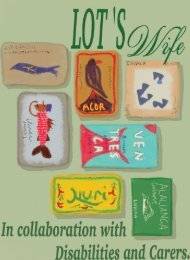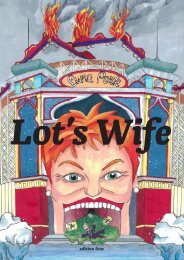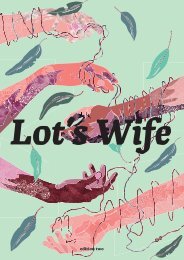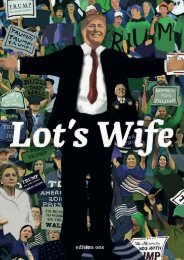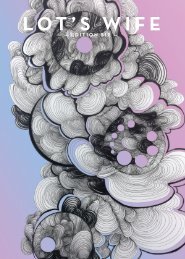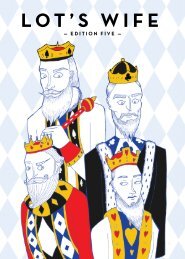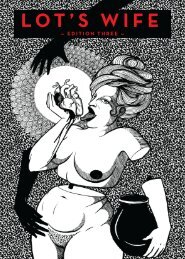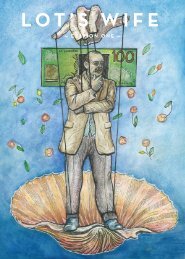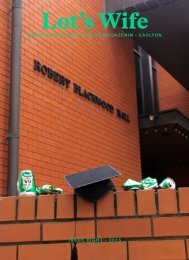Lot's Wife Edition 6 2015
Create successful ePaper yourself
Turn your PDF publications into a flip-book with our unique Google optimized e-Paper software.
ARTS & CULTURE 39<br />
Intersectionality and Feminism<br />
The Taylor Swift/Nicki Minaj<br />
Twitter Debate<br />
BY CASSIE SPRY<br />
"The intersection of forms of<br />
discrimination are important<br />
for all women to discuss as<br />
discrimination often does<br />
not happen in isolation. The<br />
problems that Minaj faces as<br />
a woman are not necessarily<br />
separate from the problems she<br />
faces as a person of colour."<br />
Taylor Swift’s response to Nicki Minaj’s tweets calling out<br />
racism in the VMAs sparked a fierce debate about which of<br />
the two feminists was in the wrong. All Swift accomplished<br />
was to derail Minaj’s valid points about discrimination in the<br />
music industry. This situation has shown the importance of<br />
intersectionality in feminism.<br />
The ‘feud’ started when Minaj tweeted her anger for being<br />
overlooked for many awards she believed she deserved<br />
nominations for in the <strong>2015</strong> VMAs. She said ‘If I were a<br />
different "kind" of artist, Anaconda would be nominated for<br />
best choreo and vid of the year as well’ and also tweeted<br />
‘When "other" girls drop a video that breaks records and<br />
impacts culture they get that nomination.’<br />
But when she tweeted "If your video celebrates women with<br />
very slim bodies, you will be nominated for vid of the year",<br />
Swift believed Minaj was personally attacking her and her<br />
video ‘Bad Blood’ rather than the racism and sizeism in the<br />
industry.<br />
Regardless of whether Minaj was talking about Swift or not<br />
(it’s more likely she was talking about Miley Cyrus’ infamous<br />
video ‘Wrecking Ball’), Swiff should not have made it all about<br />
her. Minaj was talking about something bigger than any<br />
one artist; she was talking about the structure of the music<br />
industry and how it rewards white women over women of<br />
colour.<br />
Taylor Swift demonstrated that she is a textbook white<br />
feminist by making the issue about women in general<br />
instead of engaging in how racism affects female artists.<br />
Many people feel personally attacked by the term white<br />
feminism, but it doesn’t refer to every feminist who is white,<br />
but rather to a method of feminism. It is the type of feminism<br />
that focuses on issues that affect white, middle-class,<br />
straight, abled, cis women, and ignores how different types of<br />
discrimination can intersect.<br />
In this instance, white feminism meant prioritising the<br />
experiences of sexism above the experiences of racism<br />
through Swift saying "maybe one of the men took your spot".<br />
Intersectional feminism looks at the experiences of people<br />
who face more than one form of discrimination and<br />
oppression; such as transwomen, disabled women, nonheterosexual<br />
women, religious women, and especially women<br />
of colour, and how they are often discriminated against<br />
differently because of their overlapping identities.<br />
This is crucial in a political discussion that has historically<br />
been dominated by cis white women who have purposely<br />
excluded women of colour for decades.<br />
In the fight for voting rights in Australia, white women<br />
fought for their own suffrage while still standing firmly<br />
against Aboriginal women’s (and men’s) right to vote.<br />
The Commonwealth Franchise Act (1902), which suffragettes<br />
celebrated so joyously had a clause specifically prohibiting<br />
"aboriginal native[s] of Australia Asia Africa or the Islands of<br />
the Pacific except New Zealand" from voting, unless they were<br />
already enrolled to vote in their state elections.<br />
Even in the cases where they could vote, it was strongly<br />
discouraged and many were kept ignorant of their rights.<br />
It was not until 1965 that Aboriginals across Australia<br />
had the right to vote. This could have been avoided if more<br />
suffragettes included indigenous women when they were<br />
advocating for their own rights.<br />
In light of a history of exclusion of women of colour in<br />
feminism, it is particularly important that they have a voice<br />
now and are not overshadowed by white women who insist<br />
in only discussing issues that affect all women and who<br />
use ‘solidarity’ to derail important discussions about the<br />
experiences and discrimination of women of colour.<br />
The intersection of forms of discrimination are important<br />
for all women to discuss as discrimination often does not<br />
happen in isolation. The problems that Minaj faces as a<br />
woman are not necessarily separate from the problems she<br />
faces as a person of colour. Discrimination can occur from<br />
both of these parts of her identity at once.<br />
By making the issue about her, Swift robbed Minaj of<br />
the opportunity to have a productive discussion on the<br />
discrimination that she faces in the music industry and she<br />
robbed her from being able to educate more people on how<br />
the intersection of race, gender, and body type affects her<br />
and many others.





